1995 PONTIAC BONNEVILLE fuel cap
[x] Cancel search: fuel capPage 114 of 338
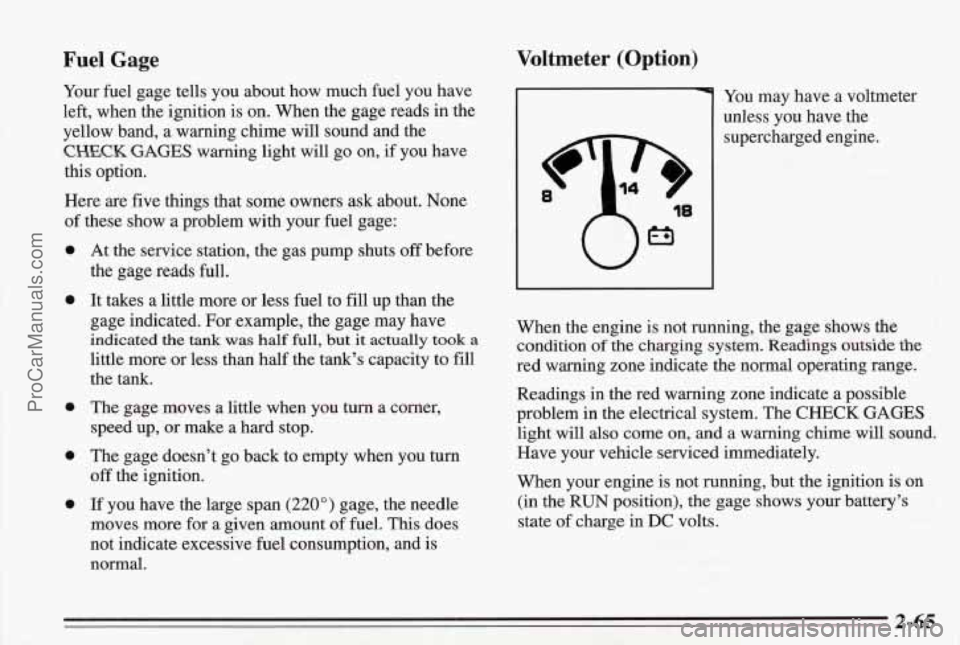
Fuel Gage
Your fuel gage tells you about how much fuel you have
left, when the ignition is on. When the gage reads in the
yellow band, a warning chime will sound and the
CHECK GAGES warning light will go on, if you have
this option.
Here are five things that some owners ask about. None
of these show
a problem with your fuel gage:
0
0
0
0
0
At the service station, the gas pump shuts off before
the gage reads full.
It takes a little more or less fuel to
fill up than the
gage indicated. For example, the gage may have
indicated the tank was half full, but it actually took a
little more or less than half the tank's capacity to fill
the tank.
The gage moves a little when
you turn a corner,
speed up, or make a hard stop.
The gage doesn't go back to empty when you turn
off
the ignition.
If you have the large span (220") gage, the needle
moves more for
a given amount of fuel. This does
not indicate excessive fuel consumption, and is
normal.
Voltmeter (Option)
You may have a voltmeter
unless you have the
supercharged engine.
When the engine is not running, the gage shows the
condition
of the charging system. Readings outside the
red warning zone indicate the normal operating range.
Readings in the red warning zone indicate a possible
problem in the electrical system. The
CHECK GAGES
light will also come on, and a warning chime will sound.
Have your vehicle serviced immediately.
When your engine is not running, but the ignition is on
(in the RUN position),
the gage shows your battery's
state of charge in
DC volts.
2-65
ProCarManuals.com
Page 171 of 338
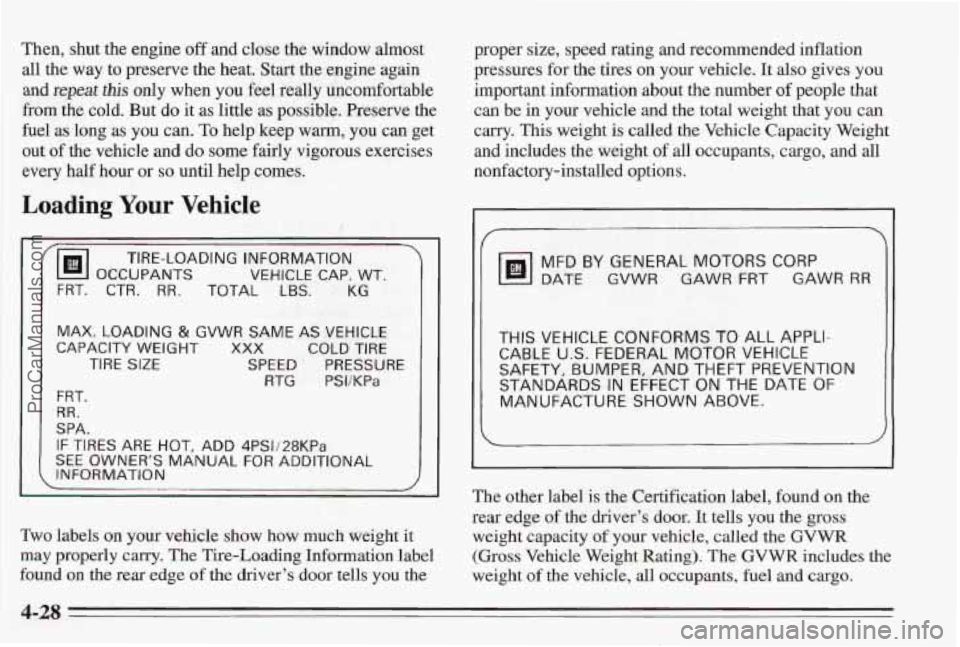
Then, shut the engine off and close the window almost
all the way to preserve the heat. Start the engine again
and repeat this only when you feel really uncomfortable
from the cold. But do it as little as possible. Preserve the
fuel as long as
you can. To help keep wm, you can get
out of the vehlcle and do some fairly vigorous exercises
every half hour or
so until help comes.
Loading Your Vehicle
d OCCUPANTS VEHICLE CAP. WT.
FRT. CTR. RR. TOTAL LBS. KG
TIRE-LOADING INFORMATION
MAX.
LOADING & GVWR SAME AS VEHICLE
CAPACITY WEIGHT XXX COLD TIRE
TIRE SIZE SPEED PRESSURE
RTG
PSI/KPa
FRT.
RR.
SPA.
IF TIRES ARE HOT, ADD 4PS1/28KRa
SEE OWNER‘S MANUAL FOR ADDITIONAL
INFORMATiON
Two labels on your vehicle show how much weight it
may properly carry. The Tire-Loading Information label
found on the rear edge
of the driver’s door tells you the proper
size, speed rating
and recommended inflation
pressures for the tires
on your vehicle. It also gives you
important information about the number
of people that
can be in your vehicle
and the total weight that you can
carry. This weight is called the Vehicle Capacity Weight
and includes the weight of all occupants, cargo, and all
nonfactory-installed options.
MFD BY GENERAL MOTORS CORP
DATE GVWR GAWR FRT GAWR RR
THIS VEHICLE CONFORMS TO ALL APPLI-
CABLE U.S. FEDERAL MOTOR VEHICLE
SAFETY,
BUMPER, AND THEFT PREVENTION
STANDARDS
IN EFFECT ON THE DATE OF
MANUFACTURE SHOWN ABOVE.
The other label is the Certification label, found on the
rear edge
of the driver’s door. It tells you the gross
weight capacity
of your vehicle, called the GVWR
(Gross Vehicle Weight Rating). The GVWR includes the
weight of the vehicle,
all occupants, fuel and cargo.
4-28
ProCarManuals.com
Page 173 of 338
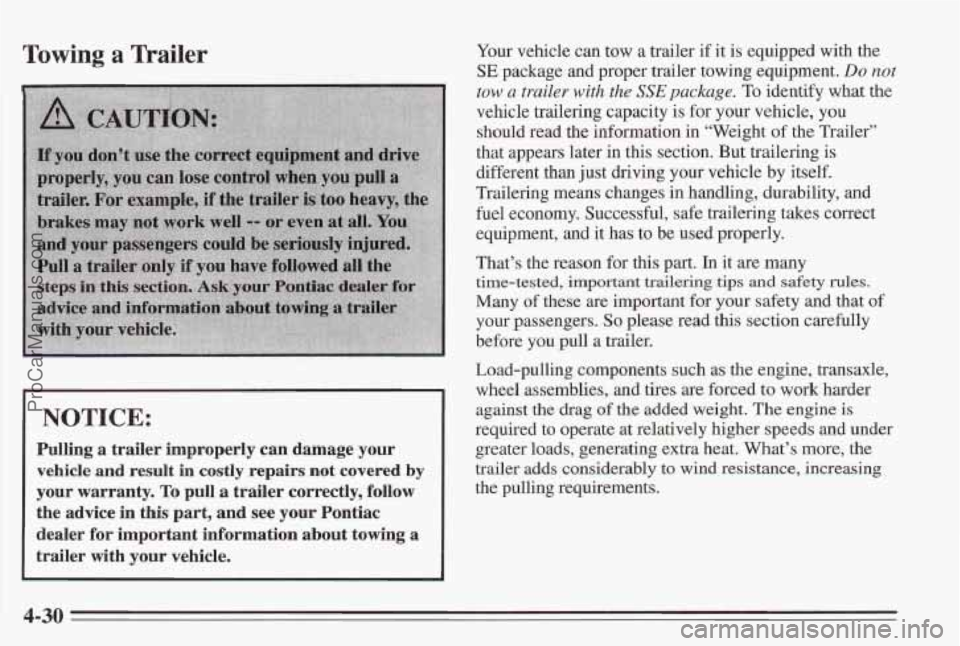
Towing a Trailer
I NOTICE:
Pulling a trailer improperly can damage your
vehicle
and result in costly repairs not covered by
your warranty. To pull a trailer correctly, follow
the
advice in this part, and see your Pontiac
dealer for important information about towing
a
trailer with your vehicle.
Your vehicle can tow a trailer if it is equipped with the
SE package and proper trailer towing equipment. Do not
tow a trailer with the SSE package. To identify what the
vehcle tmilering capacity is for your vehicle, you
should read the information in “Weight of the Trailer”
that appears later
in this section. But trailering is
different than just driving your vehicle by itself.
Trailering means changes in handling, durability, and
fuel economy. Successful, safe trailering takes correct
equipment,
and it has to be used properly.
That’s the reason for
this part. In it are many
time-tested, important trailering tips and safety rules.
Many of these are important for your safety and that of
your passengers. So please read this section carefully
before you pull a trailer.
Load-pulling components such as the engine, transaxle,
wheel assemblies,
and tires are forced to work harder
against the drag
of the added weight. The engine is
required to operate at relatively higher speeds and under
greater loads, generating extra heat. What’s more, the
trailer adds considerably to wind resistance, increasing
the pulling requirements.
4-30
ProCarManuals.com
Page 220 of 338
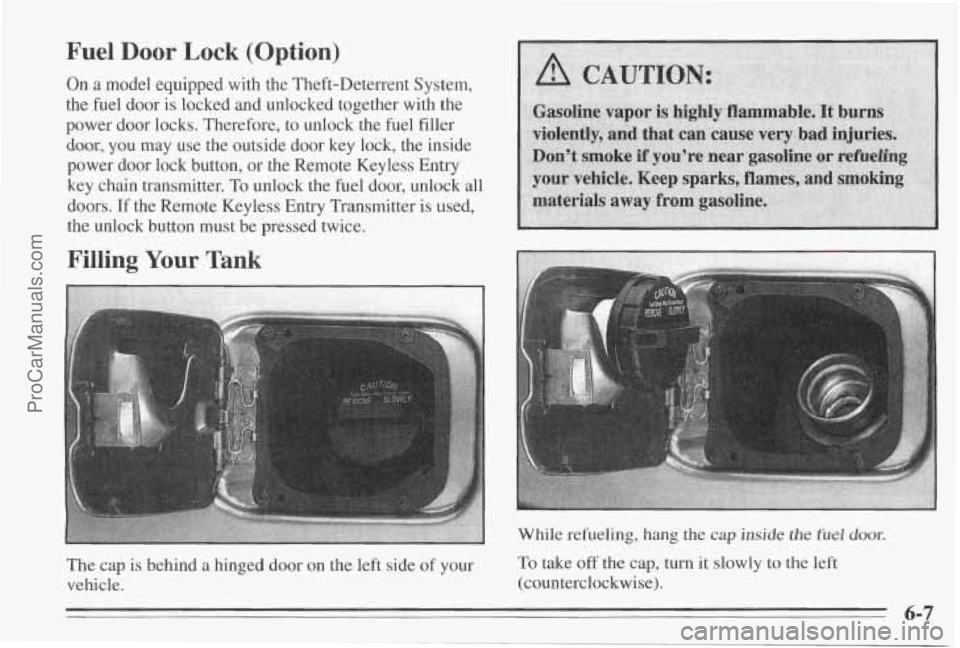
Fuel Door Lock (Option)
On a model equipped with the Theft-Deterrent System,
the fuel door is locked and unlocked together with the
power door locks. Therefore, to unlock the fuel filler
door, you may use the outside door key lock, the inside
power
door lock button, or the Remote Keyless Entry
key chain transmitter. To unlock
the fuel door, unlock all
doors.
If the Remote Keyless Entry Transmitter is used,
the unlock button must be pressed twice.
While refueling, hang
the cap inside the fuel door.
The cap 1s: behind a hinged door on the left side of your TO take off the cap, turn it slowly to the left
vehicle. (counterclockwise).
6-7
ProCarManuals.com
Page 221 of 338
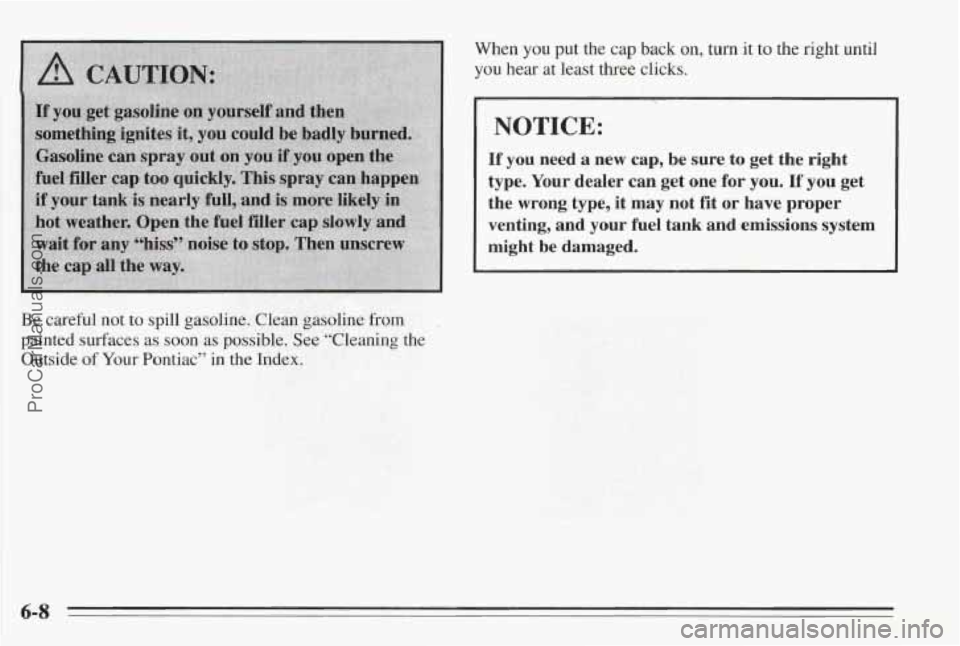
When you put the cap back on, turn it to the right until
you hear at least three clicks.
I NOTICE:
If you need a new cap, be sure to get the right
type. Your dealer
can get one for you. If you get
the wrong type, it may not fit or have proper
venting, and your
fuel tank and emissions system
might be damaged.
6-8
ProCarManuals.com
Page 226 of 338
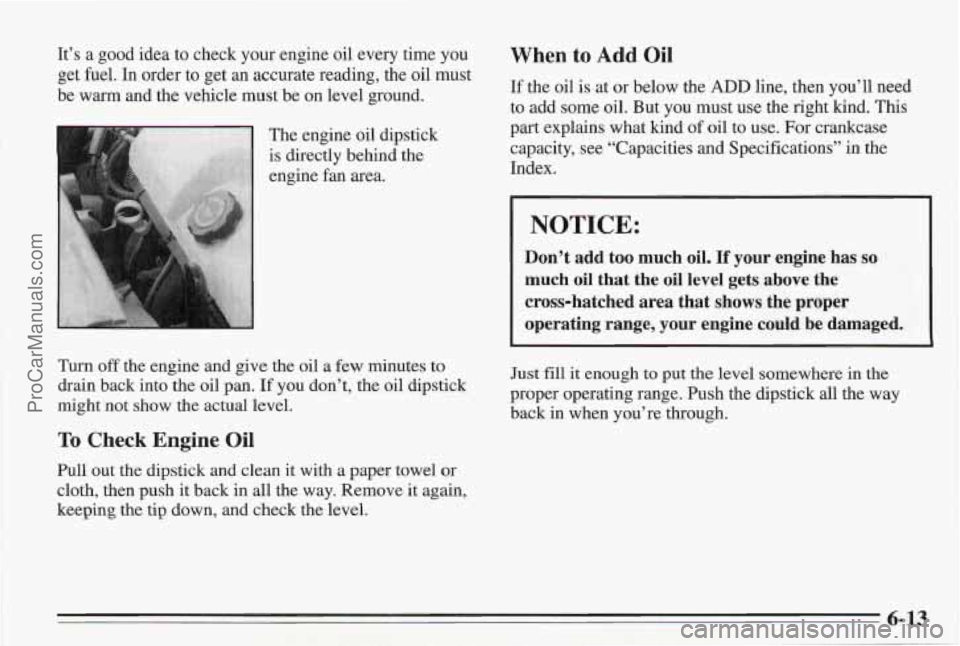
It’s a good idea to check your engine oil every time you
get fuel.
In order to get an accurate reading, the oil must
be
warm and the vehicle must be on level ground.
~ The engine oil dipstick
is directly behind the
i engine fan area.
Turn
off the engine and give the oil a few minutes to
drain back into the oil pan. If you don’t, the oil dipstick
might not show the actual level.
To Check Engine Oil
Pull out the dipstick and clean it with a paper towel or
cloth, then push it back in all the way. Remove it again,
keeping
the tip down, and check the level.
When to Add Oil
If the oil is at or below the ADD line, then you’ll need
to add some oil. But you must use the right kind. This
part explains what kind of oil to use.
For crankcase
capacity, see “Capacities and Specifications” in the
Index.
t
I NOTICE:
Don’t add too much oil. If your engine has so
much oil that the oil level gets above the
cross-hatched area that shows the proper
operating range, your engine could be damaged.
Just fill it enough to put the level somewhere in the
proper operating range. Push the dipstick
all the way
back in when you’re through.
ProCarManuals.com
Page 247 of 338
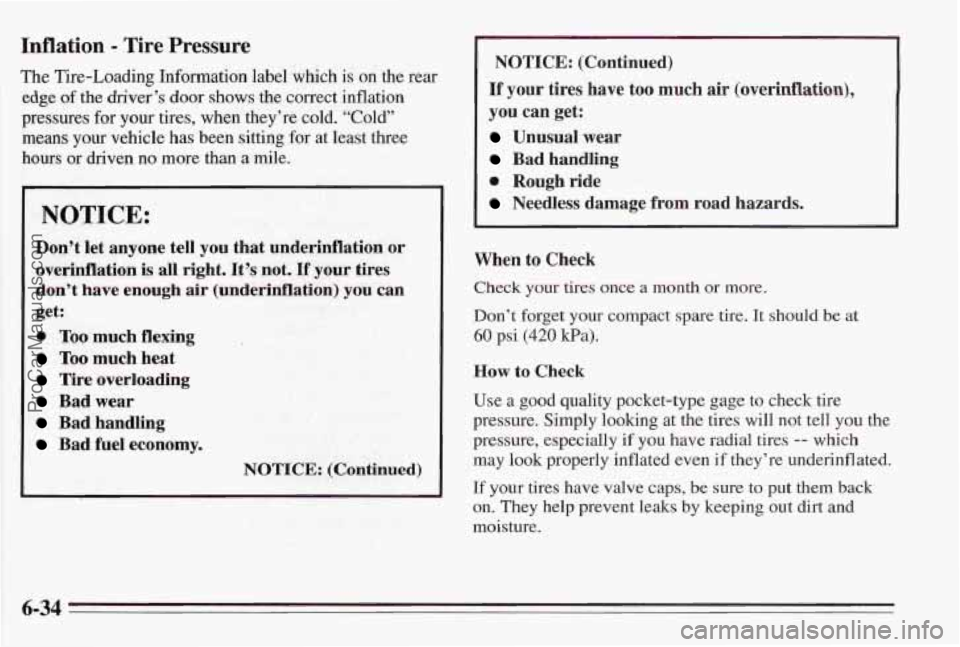
Inflation - Tire Pressure
The Tire-Loading Information label which is on the rear
edge
of the driver’s door shows the correct inflation
pressures for your tires, when they’re cold.
“Cold”
means your vehicle has been sitting for at least three
hours or driven no more than a mile.
NOTICE:
Don’t let anyone tell you that un’derinflation or
overinflation is all right. It’s not. If your tires
don’t
have enough air (underinflation] you can
get:
0 Too much flexing ’ i . ’:+?,,%
Too much heat
Tire overloading
Bad wear
Bad handling
Bad fuel economy.
. . . .> .’“’
NOTICE: (Continued)
NOTICE: (Continued)
If’ your tires have too much air (overinflation),
you can get:
Unusual wear
Bad handling
0 Rough ride
Needless damage from road hazards.
When to Check
Check your tires once a month or more.
Don’t forget your compact spare tire. It should be at
60 psi (420 Pa).
How to Check
Use a good quality pocket-type gage to check tire
pressure. Simply looking at the tires will not tell you the
pressure, especially if you have radial tires
-- which
may look properly inflated even if they’re underinflated.
If your tires have valve caps, be sure to put them back
on. They help prevent leaks by keeping
out dirt and
moisture.
6-34
ProCarManuals.com
Page 268 of 338
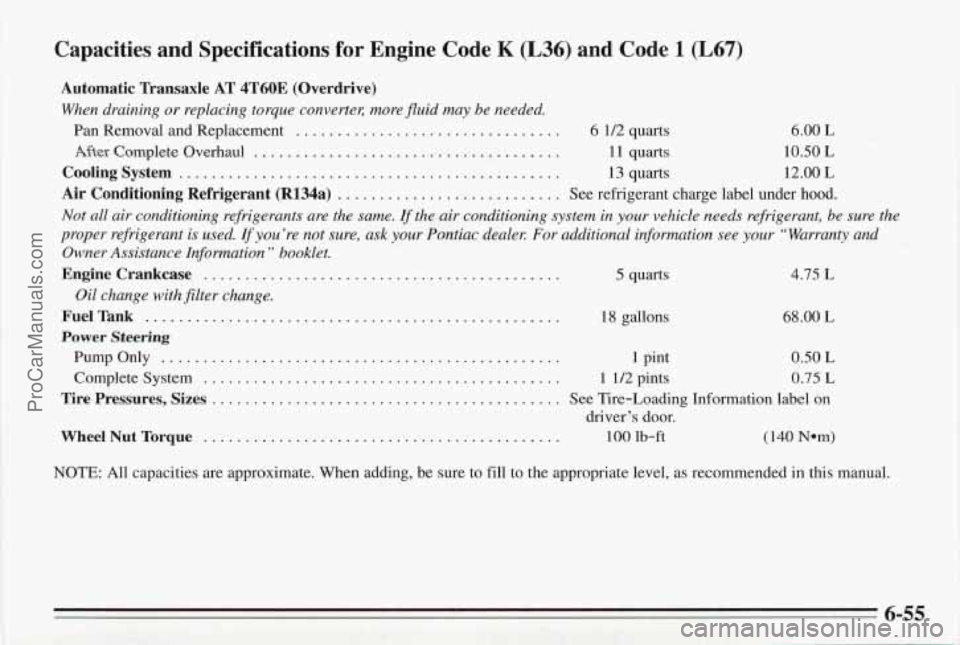
Capacities and Specifications for Engine Code K (L36) and Code 1 (L67)
Automatic Transaxle AT 4T60E (Overdrive)
When draining or replacing torque convertec more fluid may be needed.
Pan Removal and Replacement .............................. 6 1/2 quarts 6.00 L
After Complete Overhaul ..................................... 11 quarts 10.50 L
Coolingsystem .............................................. 13 quarts 12.00 L
Air Conditioning Refrigerant (R134a) ........................... See refrigerant charge label under hood.
...............................
4.75 L
Not all air conditioning refrigerants are the same. If the air conditioning system in your vehicle needs refrigerant, be sure the
proper refrigerant is used.
If you’re not sure, ask your Pontiac dealel: For additional information see your “Warranty and
Owner Assistance Information
” booklet.
Enginecrankcase ........................................... 5 quarts
Fuel Tank ................. 18 gallons
Power Steering
Oil change with filter change.
Pump Only ..... ................. 1 pint 0.50 L
Complete System ........................................... 1 11’2 pints 0.75 L
68.00 L
Tire Pressures, Sizes .......................................... See Tire-Loading Information label on
Wheel Nut Torque ... 100 lb-ft
driver’s
door. ,.. ... (140 Nam)
NOTE: All capacities are approximate. When adding, be sure to fill to the appropriate level, as recommended in this manual.
ProCarManuals.com